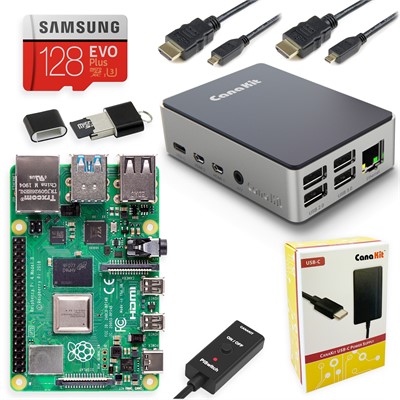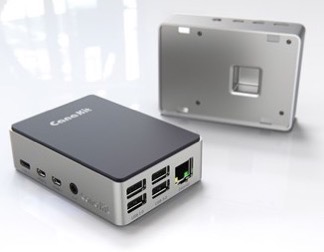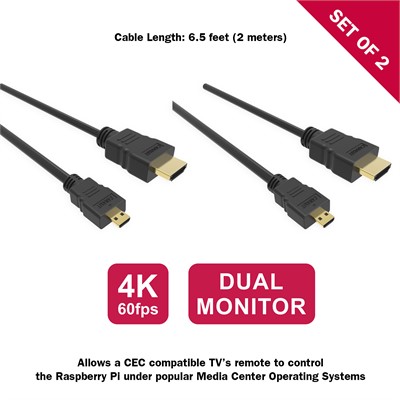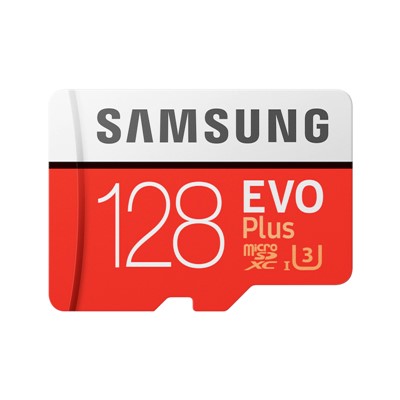
Hey everyone, happy new year! I’m Jeff Butts from The Mac Observer. I love all things Apple, but I also love to tinker with electronic gadgets like Arduino boards and Raspberry Pi. Today, I’m gonna tell you about the newest CanaKit Raspberry Pi starter kit.
If you’re not familiar with Raspberry Pi other than a tasty torte, let’s give you a brief intro. The Raspberry Pi Foundation was started in 2012 in the UK to help bring super-affordable computers to people all over the world. It boils down to an ARM-based system-on-a-chip on a small circuit board, but it really packs a punch.
Most Raspberry Pi boards include Gigabit Ethernet, 802.11ac wireless, Bluetooth, micro-HDMI ports, as well as USB 2 and 3 ports. The latest version, the Raspberry Pi 4B, has up to 8GB RAM. There’s also a GPIO header (General Purpose Input Output header) for hooking up electronics projects, but that’s outside the scope of what I’ll be talking about here.
Your operating system and storage all fit onto a micro-SD card. The whole shebang, with most Pi cases, is about the size of a deck of playing cards.
Your typical Pi board won’t cost more than $35 by itself, but that doesn’t include a case or any of the cables you need. That’s where Canakit comes in. Yeah, the Raspberry Pi Foundation sells starter kits with everything you need. But other manufacturers have jumped on the bandwagon, including CanaKit.

CanaKit’s latest starter kit is the Pi 4 Extreme, available with either 4GB or 8GB of RAM. Most Raspberry Pi cases are pretty plain and boring plastic, but this one’s different. The case you get with the Extreme kit is a premium self-cooling aluminum case. Mine is silver with a soft-touch black lid, and it looks much sexier than your typical Raspberry Pi case.
You’ll also get everything you need to get up and running except your keyboard and mouse. There are a Samsung EVO+ 128GB MicroSD card preloaded with operating systems for your Pi, a USB card reader, a USB-C power supply, and two Micro-HDMI cables. If you need more storage space, it’s pretty easy to add an external USB hard drive or thumb drive. Since the board has 2 USB 3 ports, you’ll even have fast access to those external files.

Yeah, you heard me right. This tiny computer can easily run a dual-monitor setup, and this starter kit even includes the cables for it. Even better, it fully supports 4K displays.
Now, the first thing you have to do with just about any Raspberry Pi starter kit is put it together. This is a pretty simple operation, and shouldn’t take you more than half an hour. You’ll place the Raspberry Pi board on the bottom of the case, apply the thermal pad on top of the processor, then put the top of the case on. You’ll secure it all with 4 screws.
There is an instruction sheet for this, but mine didn’t tell me about the thermal pad. I had to figure that part out on my own, but my sources at CanaKit tell me they’re soon to ship a new instruction sheet that includes that. I also noticed that my kit didn’t include the power switch pictured on the product page, but that might be different by now. This kit just came out in November.
Once that’s done, insert your microSD card into the slot on the back of the case, hook up your keyboard, mouse, and monitors. Then plug in the power supply and you’re off and running.
Once it’s up and running, you’ll have yourself a fully-functional desktop computer that performs comparably to most entry-level PCs.

The microSD card includes several operating systems, including a retro gaming bundle that lets you play classic arcade and console games and a variant of Debian Linux called Raspberry Pi OS. Assuming you already have a keyboard, mouse, and display to use, you can be up and running for less than $150 US. If you’ve got a TV with an HDMI port, you’ve got a display.
I’ve been running Raspberry Pi for years, and this latest one is totally amazing. First of all the Raspberry Pi Model B system on a chip (SoC) is phenomenal. It is super fast. With up to 8GB of RAM, you’re not going to run out of memory. It fully supports 64-bit operating systems, so if you want to install a 64-bit version of Linux, you can. Right now, Raspberry Pi is only a 32-bit operating system, but I expect that to change real soon.
It’s great for surfing the web, doing word processing and spreadsheets with LibreOffice, and programming. You can use the included Raspberry Pi OS, or any of a good half-dozen other options. I mentioned the gaming option, RetroPie, but you can also install the Kodi entertainment center software to stream your movies, television shows, and music to your TV.
You can even run Windows 10 on this baby, if that’s your thing. There’s the Windows 10 Internet of Things Edition, and I’ve even read reports of people installing the full-blown version of Windows 10 on a Raspberry Pi 4. Since the operating system runs off a microSD card, you can easily change from one OS to another just by changing cards!
You can use your Mac or your PC to install the operating system onto that microSD card, plug it into your Raspberry Pi, and boot it up.
CanaKit’s Raspberry Pi Extreme starter kit is a good way to get started. It gives you everything you need, but you do need to bring some common sense and curiosity to the game. There’s so much it can do, especially since it has the GPIO header on it. You can hook up sensors, electronics, LED lights, and I’ve even seen a kit where you can make a remote control car or truck out of the Raspberry Pi board.
If I didn’t love to tinker, I might have thrown that thermal pad out with the trash, and my Pi wouldn’t have lasted long before overheating. Another minor gotcha is that the top of the case also takes a bit of wiggling to get seated right, but isn’t too challenging.
To make a long story short, if you’re looking to get started with a Raspberry Pi, or even if you’ve been involved for a while, and want a new one to add to your collection, this Raspberry Pi Extreme Starter Kit is really one of the best ones I’ve seen. You get everything you need, even the HDMI cables to plug into two monitors. It comes with the microSD card, and not just a tiny one – a 128GB one which is good for most things you might do on the Pi. And it looks really slick!
